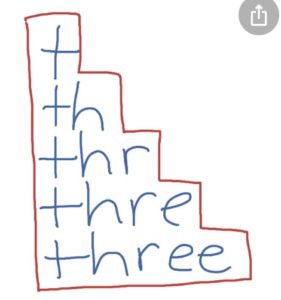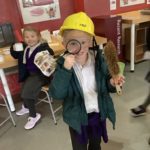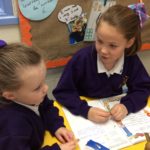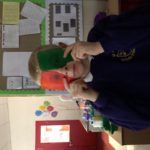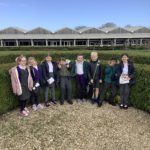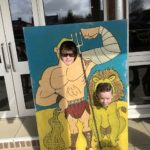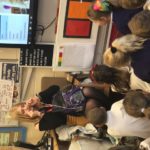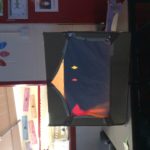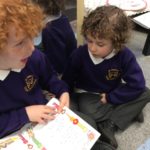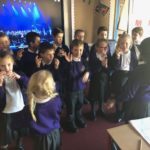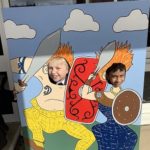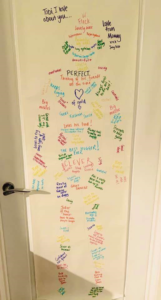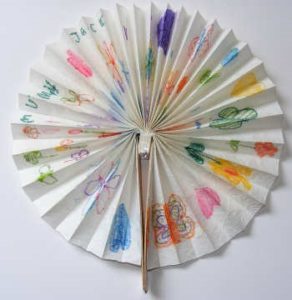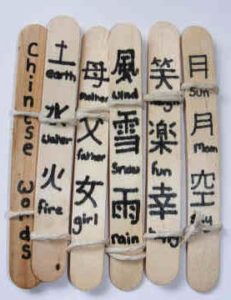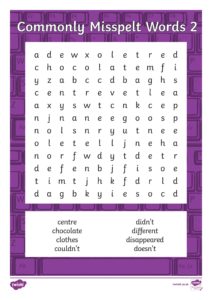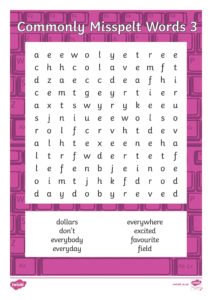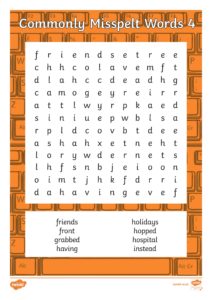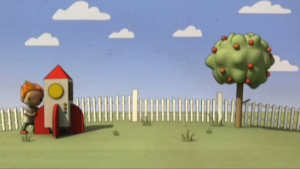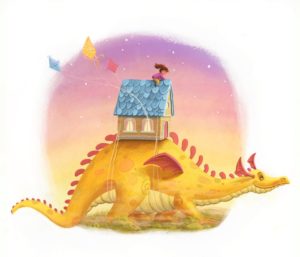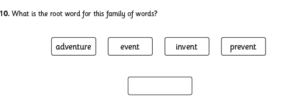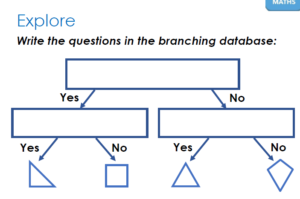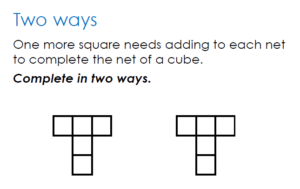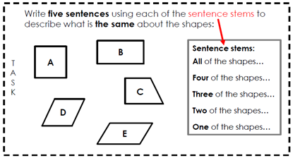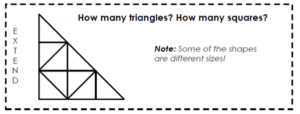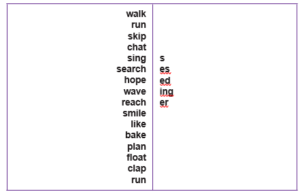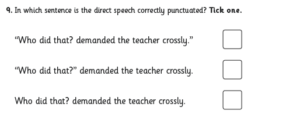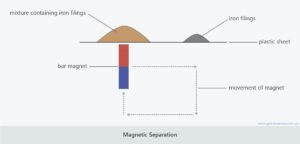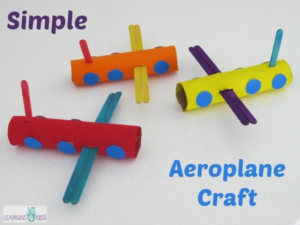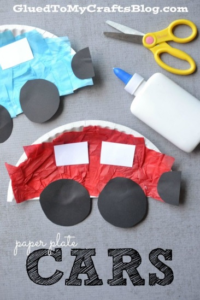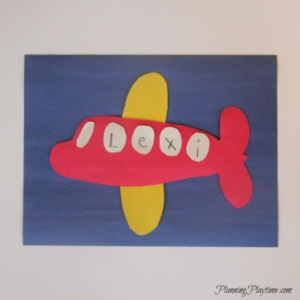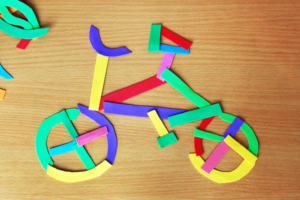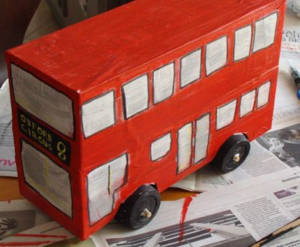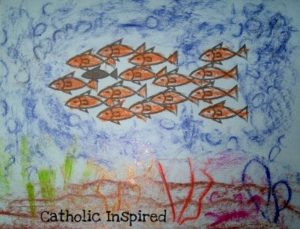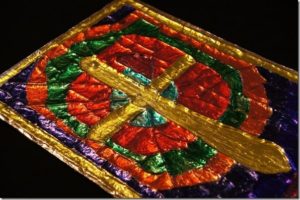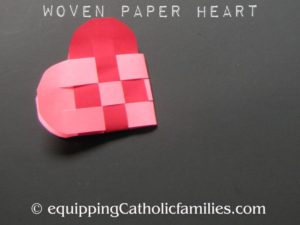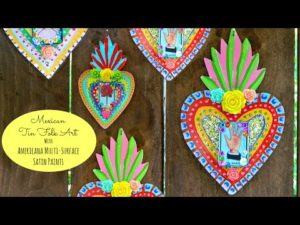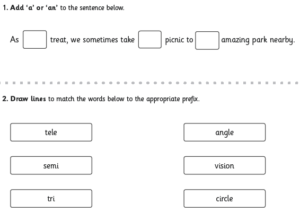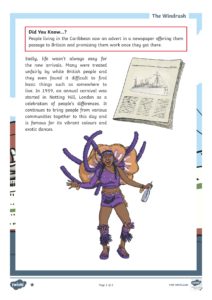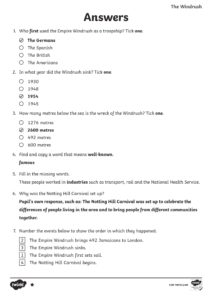Friday 16th October 2020
This week we had a special Liturgy in School. We were celebrating that we are all the disciples of Jesus. Each one of us is called to follow Jesus, every single day. The children wrote on fish cut outs how they ‘dare’ to be a disciple. For example I dare to be a disciple when I am forgiving. The children shared their dare and added them to a year group net. These are currently being displayed in the school entrance at school.
In Maths this week we were looking at multiplication and division using the times tables. We focused on the 2, 3, 5, and 10 times tables initially. Later in the week we looked at solving problems such as – ‘Zig Aliens have 3 legs and Zog aliens have 5 legs. If Mr. Chapman saw 25 legs on the school field, how many of each alien could there be?’ The children drew the problem (aliens) and then began to apply their mathematical knowledge of the times tables to solve the problem.
In English, the children have been looking at writing instructions. We have been learning about imperative verbs, prepositions and times connectives to help us write some accurate instructions for how to wash a woolly Mammoth. Next week we will be applying these skills in our writing but this time thinking about washing a sabre tooth tiger.
The focus in our spelling lessons was on the ‘or’ sound after a w. We looked at the words: worm, word, worth, worthy, worthwhile etc. In Phonics the children explored the sound -ew. We would like you to be creative with your home spellings this week. Can you make the words using lego? Can you write them using sticks? Can you write the words with chalk on the ground?
Home Learning: On Friday 23rd October we will be looking at the reading reviews again. These are completed in the Yellow reading journal. We hope to post some good examples on the blog so don’t forget to bring them in to share. There are activities to try on Sumdog again this week. Login and have a go! And don’t forget to practise your times tables on TT Rockstars too.
Congratulations to all the children who have received their pens – You need to keep them now by always writing in your best handwriting. Well done to our show stopper writers, our golden key winners and our Perfect Presentation children.
Reminder: A few children didn’t have their coats in school today and it was particularly chilly in the morning. Please remember these as it gets colder.
Have a lovely weekend to you all. We look forward to seeing you on Monday!
Team Three
Fossil detectives
This week we started to look at how Fossils are created. You could look into this more at home. Do you have fossils at home? Could you have a look at more photographs of fossils online or in books? Could you draw some fossils? If you want to bring any of your research in to show us, we’d love to see what you find out.
Maths: This week in Maths we have been looking at measure. We have been measuring old ‘mammoth bones’ and ‘sabre tooth tiger’ teeth. Towards the end of the week we looked at problems such as: If I have 3 mammoth bones each measuring 24cm, how long would the bones be in total? We looked at how we can draw the problem to help us understand it and then use this to solve it. The children were very successful! Well Done!
English: We were busy writing our setting description this week. We published our final piece on Friday. The teachers in Year 3 will be deciding if there are any candidates worthy of a pen licence this week. Next week we will be looking at instructions. If you want to get a head start, you could look for some examples of this text in your homes.
Topic: We had lots of fun creating music to fit with the sunset and sunrise at Stone Henge. The children were very creative in matching the appropriate mood and even began to record their music in early notation.
Maths: log into sumdog and have a go at the multiplication challenges available
Spelling: Finally, we looked at the ‘ar’ sound after w this week. We noticed it can sound like ‘or’ but it is spelt ‘ar’ (war, warship, toward). The phonics group looked into words with the sound ‘ue’. All children have the spellings and vocabulary work stuck into their pink books.
Word shapes:
Spelling Staircase:
Congratulations to our showstoppers, mathemagicians, and Golden key winners – All well deserved!
Have a great weekend. We look forward to seeing you again next week for lots more learning.
Team Three
E-safety talks
Year 3 Welcome Meeting : We have uploaded a new and improved version of the Welcome Meeting. Link below:
Year 3 welcome video for parents
English: This week we have started our new text in English – Stone Age Boy. The children have been using role play to explore the relationship between the characters and exploring the meanings of new vocabulary. The children have also been composing and rehearsing new sentences using exciting vocabulary. Next week we will be starting to use some of the new vocabulary in a setting description.
Maths: We have started looking at how we can use our number bonds to add 3 one digit numbers. The children were given number sentences such as 9 + 3 + 1 and had to think about how they might use their number bond knowledge to help decide the order to add these numbers – for example I know 1 + 9 = 10 + 3 more. Later in the week we applied this further to help add a two digit number and a one digit number.
Spellings: Most of the children have been learning about the -le and -el rule. For our Phonics learning we have been looking at using the sound -ay to help us with our spelling.
Science: The children have been rock detectives this week. They have been looking at different rocks and thinking about whether they might be sedimentary, metamorphic or igneous and grouping them accordingly. We were very impressed with the discussions that they were having.
Thank you to all the children who managed to complete their first book review. We were inspired by them today. Our next date for looking at the book reviews will be 9th September 2020.
Finally, but importantly, ask your children about Buddy and his tips for staying safe on a tablet. There might be a catchy tune that the children could share with you….. 🙂
Team Three
Welcome to Year Three
Hello and welcome to Year Three!
It is so lovely to have you back happy hippos and lovely lions.
Please see below a welcome video we have created- stating all of the key information about Year Three. We would appreciate it if you could watch and keep yourself informed of the homework, must read texts etc. It may help answer any questions you may have had about some of the letters been sent home recently.
Thank you for a fantastic start in such difficult times.
Have a well deserved relaxing weekend,
Miss Shaw, Mrs Stewart and Mrs Pike
Goodbye lovelies!
Well… what a year! It wasn’t what any of us expected, we are sad that our time with each other was cut short. It has been lovely to see you work so hard at home, we have loved looking at your home learning and seeing some of your smiling faces in school. We can’t believe it’s time to say goodbye to you all so soon. We hope you all have a super, super summer and that you have a fabulous start to Year 4.
Thank you so much to everyone that has brought us in presents, it is so kind of you in these difficult times.
We thought it would be nice to post some pictures of our favourite times from the year…
And last, but not least, we would like to congratulate Lion class, who are the official Year 3 champions with 2 SumDog wins to 1. Unlucky, Hippos – there’s always next year 😛
Take care everyone and have a fantastic summer.
Miss Shaw, Mrs Atkins and Mrs Pike x
Friday 10th July 2020
Hello everyone,
Somehow, strangely, we are looking ahead to our final week of the academic year. This will be the last Home Learning blog from us. We really appreciate the effort that you have all put into Home Learning and would encourage you to revisit our past blog posts over the summer to undertake any missed activities. Oaks Academy is also continuing and lessons remain live too.
To mark the end of Year 3, we are going to have a final Sum Dog competition to find the ultimate, ULTIMATE champion class. Lions and Hippos are tied on one win each, so this is the tie-breaker. You have from Monday until 3pm on Friday. Good luck!
So… here is your final Home Learning of 2019/2020!
WELL BEING: Continue with mind yeti.
Try one or more of these activities once a day for the next week.
- Lie with your back on the floor and place a soft toy on your tummy. Breathe in and out slowly and deeply and try and concentrate on the way your toy rises and falls with your breathing.
- Choose a subject to focus your thoughts or simply write about whatever arises in your mind for 5 minutes.
- Take a walk and concentrate on teha ct of walking. What movements foes each leg perform in each stride? Which part of your foot hits the ground first? What does the ground feel like underneath your shoe/foot?
- If you have any worries – write them on pieces of paper. Then when you’re finished, rip the paper up and throw them away – throwing your worries away with them
- Blow bubbles – concentrating on the way they expand and then float away.
We’ve really enjoyed hearing all about your family time during lockdown. Sometimes, when we spend a lot of time with the same people, we can get on each others nerves. Try the following activity as a way of reminding yourselves and your fabulous family, how much you love them.
- Draw round your body or draw the outline of your family member on a piece of paper. Fill that paper with all the things you love about that person and give it to them to read. Encourage all the people you live with to do this for each other. We bet it’ll put lots of smiles on your faces.
Topic:
Here are some fun Chinese craft ideas to end our china topic!
Chinese drum-
https://www.activityvillage.co.uk/chinese-drum-craft
Chinese fan-
https://www.activityvillage.co.uk/chinese-fan-craft
Chinese slat book-
https://www.activityvillage.co.uk/chinese-slat-book
SPAG: Spelling
Please find attached a selection of word searches full of commonly misspelt words. Find the best word search for you and complete.
Challenge- can you now create your own word search of words that YOU find tricky to spell.
Grammar:
Please find attached Cameron’s conjunction challenge to complete. Remind yourself of what a conjunction is and underline all the conjunctions on the sheet.
Challenge- can you create your own sentences using a conjunction?
English:
Watch the video on the link below:
https://www.literacyshed.com/thewaybackhome.html
A young boy builds himself a rocket and sends himself off to Space. He lands on a far away planet. His spaceship breaks down, a friendly alien lands and he breaks down too. The little boy parachutes to earth to get some tools to fix the ship. He gets back by way of a huge ladder, fixes the machines and then they both fly off.
Choose one or more of the following writing opportunities:
- Write a diary/recount of the adventure in the video.
- Build a rocket and decide where it is going – write your own adventure story. Maybe you could film the story yourself.
- Write a holiday brochure page for their destination.
- Write dialogue between the boy and the alien.
- Write a description of the alien or the strange place in which they land.
Skills you’ve learnt in year 3 that you could use:
-Fronted adverbials.
-High level vocabulary (using a thesaurus to choose specific and relevant words)
– Descriptive language – expanded noun phrases, similes, metaphors, alliteration.
– Speech – correctly punctuated and a variety of words for ‘said’.
If you prefer to use the Oaks Academy lessons-
https://classroom.thenational.academy/lessons/story-reading-comprehension-predict-and-inference
https://classroom.thenational.academy/lessons/setting-description-reading-comprehension-word-meaning
https://classroom.thenational.academy/lessons/setting-description-write-a-setting-description-fc305c
Maths
Lots of you have been cooking and baking at home over these last few months so we think it’s really important to be able to accurately read scales and measure carefully.
https://classroom.thenational.academy/lessons/read-a-scale
https://classroom.thenational.academy/lessons/read-capacity-and-volume
https://classroom.thenational.academy/lessons/compare-capacity-and-volume
https://classroom.thenational.academy/lessons/ordering-capacity-and-volume
https://classroom.thenational.academy/lessons/add-and-subtract-capacity-and-volume
https://classroom.thenational.academy/lessons/solve-problems-involving-capacity-and-volume
Challenge-
Guided reading
GIRL ON A HOUSE ON A DRAGON
- What happened before this picture?
- How did the house get on top of the dragon? Who tied it onto the dragon’s back?
- Is the dragon happy about this?
- How do the girl and the dragon know one another?
- Why is the girl sitting on top of the house and not inside it?
- Is anyone else inside the house?
- Where did the kites come from?
- Where are the girl and the dragon going?
- Why are they travelling in this way?
- Give this picture a more interesting title.
Challenge: Compare this picture with the picture below titled ‘Best Friends’.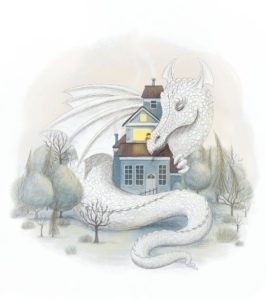
What’s similar and what’s different?
Which image do you prefer and why?
Does the dragon belong to the boy, or does the boy belong to the dragon?
Religious Education – Miss Honeywell
As we approach the end of the school year and consider our journey in faith towards God, now is a great time to reflect upon each of the Sacraments that form a special part of this journey. Please choose ONE of the seven Sacraments below: Baptism, Holy Communion, Confirmation, Marriage, Holy Orders, Reconciliation or Anointing of the Sick.
With your chosen sacrament, have a go at ONE of the following tasks…
- Write a prayer or poem about your favourite Sacrament. How could you ask for God’s blessing and guidance throughout your Christian journey? Describe how you would feel during the Sacrament.
- Create a stained glass window to represent the key symbol(s) of your chosen Sacrament. What do these symbols mean and why do you think that they are they important?
- Can you find any photographs at home from when you or a family member took part in any of the Sacraments? Discuss what the experience was like and what you can both still remember.
- Make a set of game cards to help you remember each of the sacraments (e.g. Snap, Pairs, Dobble) and how they are similar or different to one another.
- Are there any special garments or items of clothing that you would wear when taking part in your chosen Sacrament? Design an appropriate outfit – which colours or details would be suitable?
- Research how your chosen Sacrament is celebrated across different churches and countries. How do the celebrations compare to each other? Is there anything that surprised you?
Music from Mrs Sumba
Think back over the past school year which started in September 2019. What can you remember doing? Make a list of these things.
Now think of a tune you know well.
Using this tune and the list you have written, can you compose a song about this school year? Perhaps you could record yourself singing it.
Science from Miss Stapley
Spaghetti Towers https://www.rigb.org/families/experimental/spaghetti-towers – to watch the video
The activity:
- Make a tower from spaghetti and marshmallows.
- Experiment with the construction of your tower to find out which shapes are best for building with.
- Learn why some shapes are more stable than others when you build a tower. https://www.rigb.org/docs/spaghettitowers_infosheet_0_1.pdf – for the full information on the activity and questions to ask your child(ren)
You will need:
Packet of spaghetti (uncooked) • Packet of marshmallows
What to do:
Challenge a child or children to use marshmallows (whole ones or pieces) to join lengths of spaghetti together to make the tallest tower possible. You could start by building a simple cube and seeing what you need to do to make a taller structure that remains standing.
Going Further challenge:
- Instead of building a tall tower, you could try to build the strongest bridge from spaghetti and marshmallows.
- You could limit the amount of spaghetti and number of marshmallows to make the task more difficult.
- You could give children a budget with which to ‘buy’ spaghetti and marshmallows and make the ‘cost’ of the tower another element they have to consider.
- Try out this interactive ‘shapes’ lab to see how forces affect different shapes: http://bit.ly/ShapesLab
Have fun!
Friday 3rd July 2020
Happy Friday everyone, we hope you’re all well. It has been so, so wonderful to see so many of your lovely faces this week. We can’t believe how much we’ve laughed and how much you’ve grown! We are so proud of you all and the soon-to-be Year 4s that you’ve become.
We can’t quite believe it but here is your penultimate Home Learning blog before the summer…
WELL BEING: Mind Yeti. Google Mind yeti and follow the videos.
 It’s been a hot week and you’ve had a busy few weeks with all your fantastic home learning. Take some time for you. You can do this alone or with members of your family – even with your friends over face-time or zoom.
It’s been a hot week and you’ve had a busy few weeks with all your fantastic home learning. Take some time for you. You can do this alone or with members of your family – even with your friends over face-time or zoom.
The mind yeti videos are all about mindfulness. Many of you may have lots of things going round in your heads, maybe lots of thoughts about school next year and how it will be, who your new teacher will be etc. Maybe things are starting to change again at home with parents returning to work. Maybe you are struggling to get to sleep at night because of the heat – watch the videos and try and do at least 10 minutes of Mind Yeti every day.
Topic: Chinese cuisine.
Have you ever eaten Chinese food? What’s your favourite?
Research Chinese cuisine (there is a PowerPoint to help you). Record any interesting information you find and then complete the activity below.
Fancy making Chinese food at home? Here’s a link to 10 family friendly recipes to try:
https://www.thespruceeats.com/chinese-food-recipes-for-kids-2097961
SPAG: Spelling- Your turn to be the teacher!
The following sentences have spelling errors. They will be found in spellings words we have covered this year. Can you proof read the sentence and correct the mistakes? Be careful as there may be more than one in each sentence.
1, The little girl skiped to school.
- The Cheshire cat smild at Alice with a wide grinn.
- I was unhapy when my football team lost there match.
- Their was just about enogh money in my purse to by the magazine.
- My freind doe’snt have a dog.
- The breaks on my bike weren’t working so I crashd into the pond.
- I wanted to where my spoty dress to the party.
- My sister was worryd that shed be late for school.
- My teacher thort I was being naughty but I was trying to be helpfull.
- Carlessly, I through away my train ticket.
Grammar:
- ROOT WORDS AND WORD FAMILIES.
Challenge: What does the root word mean? Can you think of other words that have it as a root word?
Challenge: Take the word believe as your root word. How many other words are in this family? E.g. believable, belief.
- VOWELS AND CONSONANTS:
What is a consonant? What is a vowel? Can you list them?
English:
Activity 1: Start or finish your dragon newspaper report from last week’s home learning. As said last week, this should have taken you quite a white as it is important to spend some quality time following the steps that we do in school when writing so that you produce the best piece of writing you can.
- Plan your writing
- Write your first draft
- Spend some time editing and improving – monkey ears, read it through with an adult, use a thesaurus to improve word choices, check all your sentences don’t start the same, check spelling and punctuation.
- Then publish – be proud of your hard work. There are many blank templates on line to help you present your work correctly. Here is a link to help https://www.twinkl.co.uk/resources/planning-writing-writing-composition-english-key-stage-1/writing-frames-and-templates/newspaper-templates
WHEN WRITING:
First, create a name for your newspaper and a headline for the article.
After that, write your newspaper article – remember to include:
- Who, where, when and what, how! Go back to your research to find this information.
- How people reacted and felt – this is a good time to use your speech.
- What is going to happen next (be creative)
- Conclude with somewhere that people can go / call / email for help, to give more information, for support.
SUPPORT: Use the example template for a similar news article that you can use a model to support you.
Challenge:
Vary your sentence structure: Can you use a fronted adverbial to show (e.g. Still shaking in fear, Mrs. Pike stated she was just so grateful that the children weren’t in school at the time of the attack.) Word mat provided to remind you of the options. https://content.twinkl.co.uk/resource/f5/c4/t-l-4647–fronted-adverbials-ks2-word-mat-list-_ver_6.pdf?__token__=exp=1592815621~acl=%2Fresource%2Ff5%2Fc4%2Ft-l-4647–fronted-adverbials-ks2-word-mat-list-_ver_6.pdf%2A~hmac=60e431cd62337003b83721978d6b06603200626e08fd5407893a343bd8ff2054
Can you use a subordinate clause (Mrs. Atkins, a year 3 class teacher, was shocked by the damage caused.)
Activity 2: POETRY
Look at the following Bitezize videos about different types of poetry.
https://www.bbc.co.uk/bitesize/topics/z4mmn39
Choose a style of poetry and write your own poem about dragons (you can write more than one in a different style if you’d like to.)
Use the following to help:
– the dragon poems from guided reading last week
– the dragon word mats from your previous home learning.
– the new dragon vocabulary sheet linked to this weeks guided reading.
REMEMBER: Use high level, creative vocabulary.
Challenges: You don’t have to do all of these but they are features of poetry to consider when planning and writing your own.
Can you make it rhyme? (But it still make sense)
Can you use alliteration?
Can you use similes and metaphors? (As, as or like – remember the song? https://www.youtube.com/watch?v=Hwq5ptwr_-4)
Can you use onomatopoeia?
If you’d prefer more guidance to create your own poems, follow this sequence of Oak Academy lessons…
https://classroom.thenational.academy/lessons/poetry-write-a-sound-poem
https://classroom.thenational.academy/lessons/read-the-example-and-identify-the-key-features-12d697
https://classroom.thenational.academy/lessons/key-feature-spag-focus-1d3400
Guided reading
Use the picture – discuss and record your responses in any way you wish. There is no right or wrong – use inference and your imagination.
- What can you see? What do you think is happening/has happened/will happen? What do you wonder? Complete the See, think wonder resource sheet.
- Who owns this boat? Where is it from? Where is it going? Who travels on this boat?
- What can you see beneath the surface of the water?
- What is the creature called? Describe the creature. Consider its eyes, mouth, legs, tail and other details.
- What is the creature doing?
- Why does it have the anchor chain in its mouth?
- Has the creature been asked to pull the boat in this way? Is it under control or out of control?
- Where is it taking the boat?
- Why is it acting in this way?
- Why are the fish swimming alongside the creature?
- Who is in the hot air balloons?
CHALLENGE
Write a 100-word story about this picture. Try to include some of the words on the dragon vocabulary page.
Maths
Here are the next three Oak academy lessons to complete.
https://classroom.thenational.academy/lessons/to-describe-the-properties-of-3d-shapesMaths
https://classroom.thenational.academy/lessons/to-identify-and-describe-symmetry-in-2d-shapes
https://classroom.thenational.academy/lessons/to-revise-shapes
Challenge one-
Challenge two-
Challenge three-
Challenge four-
Science
Have a go at this End of Unit Assessment to see how much you’ve learned about Forces and Magnets. Ask a grown up or older sibling to mark it for you using the answers page. If there’s an area which you could improve upon, re-read the previous weeks lessons or do extra research on BBC Bitesize https://www.bbc.co.uk/bitesize/topics/zyttyrd
Art from Mrs Pearson:
Art Challenge For Father Jeremy:

Father Jeremy has got a very special celebration coming up on 26th July this year. He will be celebrating 45 years since his ordination into the priesthood. I think this is a remarkable achievement and should be marked by your incredible artwork. Therefore, your Art challenge for the next fortnight is to produce a piece of art for Father Jeremy. This can take any form you like from street art, a drawing, collage or even some edible art! As well as being a priest, Father Jeremy has a wide range of interests including walking, reading and nature. So let your creative juices flow and come up with something spectacular…. I know you will!
As I have mentioned, this is a two-week challenge and I would ask that, as well as me displaying your art on the Blog, would you please keep hold of it (yes even sculptures you may make), so that I can collect it from you, when we are all back in school and put it in a book and then present in to Father Jeremy.
As always, you can still send any other art work to me and I will post that on the Blog too.
Please email your artwork to me:
n.pearson@stpeterswaterlooville.hants.sch.uk
Thank you
Keep creating and keep safe!
Mrs Pearson
Music from Mrs Sumba
Over the past few weeks, you have listened to 10 pieces of music composed by Musical Trailblazers. Go to the website below and listen to them again.
https://www.bbc.co.uk/teach/ten-pieces/ten-pieces-trailblazers/zfpy7nb
Which was your favourite and why?
Which was your least favourite and why?
Science from Miss Stapley
If your child has an allergy to eggs – please choose another exciting investigation from https://www.rigb.org/families/experimental
Bouncing Eggs
https://www.rigb.org/families/experimental/eggsperiments – watch the video
- Make an uncooked egg bounce!
- ExpeRiment with different liquids to see what effect they have on eggs.
- Learn how the acid in household liquids like orange juice and vinegar react with eggshells and make them dissolve, leaving the inside of the egg intact.
https://www.rigb.org/docs/dissolving_eggs_infosheet_v2_0_1.pdf – download worksheet for instructions and questions to ask before and after the investigation.
You will need:
5 eggs • Glasses or jars that an egg can fit inside comfortably • Cling film • Oil • Milk • Water • Vinegar • Orange juice
Going further challenge:
- You can use the shell-less eggs you make from this experiment to do another activity which will let you shrink and expand the eggs by placing them in different liquids: http://bit.ly/nakedeggs
- Watch a video of how to make a coloured bouncy egg, then try making one yourself: http://bit.ly/RubberEgg
26th June 2020
Hello Happy Hippos and Lovely Lions,
We hope you are well! We are so looking forward to meeting up with you next week, we hope you are too.
Here is next weeks homelearning- enjoy!
Topic:
Here are some fun facts about Chinas terracotta army-
https://www.childrensmuseum.org/blog/10-amazing-facts-about-the-terra-cotta-warriors
Have a look at the PowerPoint information on the terracotta army too-
Using this information you could make-
- A quiz for your friends to answer about the army
- A PowerPoint of the information you have found out
- A story about the army using the facts you have learnt
- An information booklet
Maths
Here are the next two oak lessons on 2D shapes.
https://classroom.thenational.academy/lessons/to-describe-2-d-shapes-based-on-their-properties
https://classroom.thenational.academy/lessons/to-draw-2-d-shapes-based-on-their-properties
If you fancy a challenge…
Challenge 1-
Challenge 2-
Challenge 3-
https://nrich.maths.org/7192/note you can use shapes from home, draw your own shapes or print off the sheet if you can to solve this problem.
SPAG: Spelling-
We are going to recap the suffixes ‘s’ ‘es’ ‘ed’ ing’ ‘er’
Using the grid words how many different accurate words can you create using these suffixes? Remember some words will be used more than once.
Challenge- can you use these words in a sentence?
Grammar:
What is a consonant? What is a vowel?
https://www.bbc.co.uk/bitesize/topics/zxfyjty/articles/zs2crdm
CHALLENGE: Write as many prepositions that you can think of then choose 5 to write into descriptive sentences?
CHALLENGE: Can you explain how you know which one is correct and which ones are incorrect?
English
Activity 1: Headline vocabulary:
A headline should be short, snappy and give the reader an idea about what the story is about. It should also make them want to read on.
They try to use words that grab the reader’s attention. Complete the vocabulary task.
Activity 2: Create your own headlines!
Carefully read these short newspaper stories and create an interesting headline for each, which will grab the reader’s attention. Using a thesaurus (online if you don’t own one) would be an excellent way to help with interesting vocabulary choices. CHALLENGE: Can you use alliteration?
- Three children were walking across a field in Waterlooville when they discovered a hole. At the bottom of the hole was a chest filled with gold and silver. The children ran and told the police about their discovery.
- Two days ago a kitten called Cookie, belonging to Mrs Edge, climbed a tree. It got stuck at the top and could not get down. A large crowd gathered. They could not help the cat. In the end they sent for the fire brigade. The firemen put a ladder up the tree and brought the frightened cat down.
- Late last night, three men disguised wearing wigs and sunglasses stole over £1000 worth of goodies from a sweet shop. They smashed their way through the front door around midnight and filled sacks with delicious treats. It is hoped that they will be found and arrested soon.
- Cunningham, a local headteacher, is celebrating his first prize win at a local gardening contest. His beautiful display of flowers beat many other contestants. Rumours have it that his own back garden looks better than the Queen’s! Photographs of his display can be seen on our website.
Activity 3: Now you’ve practiced lots of the features of an article, you are ready to report on the School dragon story. THIS WILL BE PART OF NEXT WEEK’S LEARNING TOO – it is important to spend some quality time following the steps that we do in school when writing so that you produce the best piece of writing you can.
- Plan your writing
- Write your first draft
- Spend some time editing and improving – monkey ears, read it through with an adult, use a thesaurus to improve word choices, check all your sentences don’t start the same, check spelling and punctuation.
- Then publish – be proud of your hard work. There are many blank templates on line to help you present your work correctly. Here is a link to help https://www.twinkl.co.uk/resources/planning-writing-writing-composition-english-key-stage-1/writing-frames-and-templates/newspaper-templates
WHEN WRITING:
First, create a name for your newspaper and a headline for the article.
After that, write your newspaper article – remember to include:
- Who, where, when and what, how! Go back to your research to find this information.
- How people reacted and felt – this is a good time to use your speech.
- What is going to happen next (be creative)
- Conclude with somewhere that people can go / call / email for help, to give more information, for support.
SUPPORT: Use the example template for a similar news article that you can use a model to support you.
Challenge: Vary your sentence structure: Can you use a fronted adverbial to show (e.g. Still shaking in fear, Mrs. Pike stated she was just so grateful that the children weren’t in school at the time of the attack.) Word mat provided to remind you of the options. https://content.twinkl.co.uk/resource/f5/c4/t-l-4647–fronted-adverbials-ks2-word-mat-list-_ver_6.pdf?__token__=exp=1592815621~acl=%2Fresource%2Ff5%2Fc4%2Ft-l-4647–fronted-adverbials-ks2-word-mat-list-_ver_6.pdf%2A~hmac=60e431cd62337003b83721978d6b06603200626e08fd5407893a343bd8ff2054
Can you use a subordinate clause (Mrs. Atkins, a year 3 class teacher, was shocked by the damage cause.)
Guided reading: Dragon poems.
Here are 4 short poems about dragons. Read them aloud, you could even perform them if you want to.
Poem 1: Ancient Dragons
Dragons, they say, lived long ago.
Where they came from, I do not know.
Some like to fly and roar and prance.
Others are colourful and love to dance.
Long tails,
Huge wings,
Golden eyes,
Sharp claws,
Scaly skin,
Forked tongue …
I’m glad they don’t live here any more.
Poem 2: Fly Dragon Fly
Fly, dragon, fly,
Higher and higher.
Breathe, dragon, breathe,
Flames of fire.
Blink, dragon, blink,
Your eyes of gold.
Sleep, dragon, sleep.
You are ever so old.
Poem 3: Friendly Dragons
Friendly dragons are fun,
Flying through the air.
If it wasn’t for their fiery breath
You’d hardly know they were there.
They like to make sandcastles,
And play football in the park,
And thanks to their fiery breath
You can find them in the dark!
Poem 4: My New Pet.
My new pet is a curious kind.
It popped out of an egg that I did find.
With beady eyes and curly claws
And razor sharp teeth filling its jaws.
Enormous wings like leathery sails,
Scaly armour right down to its tail,
Roaring and huffing and puffing out fire,
To eat you for dinner is all it desires.
It’s not a snake, or a lizard, or bat …
My pet is a DRAGON!
How about that?
Which one do you prefer and why?
Look at the styles, shape, rhyming patterns and rhythm when reading them. Make notes around the poems, draw pictures of what comes to mind (like a read aloud think aloud).
Hint: These might help you with your English next week.
Science
Have you noticed that when you play with magnets, they don’t need to be touching to have an effect on a magnetic object? Using magnetic force to act on objects from a distance happens all the time at scrapyards. Watch this video here https://www.bbc.co.uk/bitesize/clips/zcntsbk .
Can you draw and label a scientific diagram, showing either the rotating magnet or the plate magnet and its use at the scrapyard? Here is an example of a different experiment, drawn as a scientific diagram. Notice how the drawings are simple and the illustrator has used a ruler.
Challenge – Explain the effect that electricity had on the plate magnet.
Music from Mrs Sumba
Hans Zimmer
Go to the website below and watch Naomi Wilkinson’s video about Hans Zimmer
https://www.bbc.co.uk/teach/ten-pieces/classical-music-hans-zimmer-earth/zh4k382
Why is Hans Zimmer considered a musical trail blazer?
Now listen to the whole piece in the second video.
Zimmer tells us to,
‘Do what you wanna do with it!’
How can you ‘play and get creative’ with this piece?
Science from Miss Stapley
Giant Bubbles https://www.rigb.org/families/experimental/giant-bubbles – watch the video
- Make a home-bubble mixture and wands. Use them to look more closely at the characteristics and behaviour of soap bubbles.
- Experiment with different shapes and sizes of bubbles and see what you can and cannot control about bubbles. Learn how to make giant bubbles and find out why bubbles are usually round.
- Learn how to make giant bubbles and find out why bubbles are usually round. https://www.rigb.org/docs/giantbubbles_infosheet_0_0.pdf – details on the information sheet.
You will need:
- Good quality washing up liquid
- Water
- Glycerin (optional)
- Plastic tub or other container for bubble mixture
- Measuring jug (optional)
- Various things with holes in them for blowing bubbles with. Watch the video for ideas. Straws, pipe cleaners, paperclips, coat hangers, cookie cutters and cake tins with removable bottoms are all particularly good.
- For giant bubbles: wooden spoons (or other sticks), a couple of metres of string and a small weight you can thread through it, like a metal key ring or nut.
What to do:
A mixture we found that works is 1 litre of water, 100ml of washing up liquid and 30 ml (2 tablespoons) of glycerin. Blow some bubbles!
Put a straw into your bubble solution and try blowing gently into the liquid. You should be able to make a lot of bubbles very quickly. Then dip one end of a straw into the solution, take it out and blow gently through the other end. See if you can control the size of bubble you can blow out of the straw.
Try making bubbles using things with bigger holes, like a paperclip or pipe cleaner bent into a circle. Try poking a dry finger into a bubble, then try the same thing after dipping your finger in bubble solution.
Try making bubbles inside bubbles by poking a straw dipped in bubble solution into an existing bubble and blowing again.
Try out objects with different shaped holes, like cookie cutters or pipe cleaners bent into other shapes. Try objects with really big holes, like a coat hanger or a cake baking tin with its bottom removed. Try making giant bubbles with the special wand we show you how to make in the video.
Going Further:
- You can experiment with your bubble mixture and giant bubble wand to see just how big you can get your bubbles to be. There are lots of different bubble mixture recipes on the internet, just search for “soap bubble recipe”.
- You could try making two or three of them and comparing how good the bubbles they make are.
Re from Miss Honeywell
Our school patronal feast day takes place on Sunday 28th June. In order to prepare for this special time of the year, please choose ONE of the following activities in order to learn more about St. Peter…
- Write a diary entry as St. Peter, when he escaped from prison. Describe how he felt when the Lord sent an angel to free him from the jail that Herod had cruelly locked him up in. How did they get out of the prison?
- Jesus told Peter, ‘I will give you the keys to the Kingdom of Heaven’. Design the keys and include as many symbols as you can to represent St. Peter and why he was so special. What would the keys be made of?
- Jesus said to Peter, ‘You are a rock, and on this rock I will build my church’. Could you paint or decorate a stone or pebble, to show ways in which to build God’s church? (e.g. by spreading love, faith and Good News).
- Create a selection of short prayers to ask for God’s guidance during the global pandemic. How could we demonstrate the courage, faith and commitment that was demonstrated by St. Peter, as we work to support others?
- Take a look at the St. Peter’s logo on our school website. Can you re-design the crest so it reflects the qualities of St. Peter? (e.g. trust, hope, responsibility). Why did Jesus say ‘feed my lambs’? How might St. Peter ask us to continue God’s work on earth?
- Use the internet to research St. Peter – can you make a fact file about our school saint? Which key words might you use as part of your factual information page? Were there any articles about St. Peter that particularly interested or surprised you?
Art from Mrs Pearson:
Art Challenge: The Great Getaway! TRANSPORT
The title for your art this week is The Great Getaway! TRANSPORT. This can take the form of a drawing, a painting, a sculpture, a collage or anything else that you would like to create. As always, I’m sure you will impress me with your creativity! Here are some ideas:
CHALLENGE: Design your own vehicle, maybe one that flies and can float on water!
However, if this doesn’t appeal to you then you can still send any other art work to me and I will post that on the Blog too. Please email your artwork to me:
n.pearson@stpeterswaterlooville.hants.sch.uk
Thank you
Keep creating and keep safe!
Mrs Pearson
Have another lovely week Year Three!
Art homelearning
Art Challenge Feast Days
We have two important Feast Days in our Church calendar for June. The 19th June is the Feast of the Sacred Heart and 29th June is the Feast Day of St Peter and St Paul.
For your art challenge this week I would you to do a creation linked to either of these Feast Days.
The Sacred Heart of Jesus is an object of devotion and always falls 19 days after Pentecost.
As you know, St Peter was given the ‘keys to heaven’ by Jesus and was our first Pope and in Matthew Ch16v18 Jesus said ‘And I tell you, you are Peter, and on this rock I will build my church.’ He is also the Patron St of fishermen. St Paul changed from not believing in Christianity to spreading the word through the letters that he wrote. Naturally, he is the Patron St of writers.
Ideas to inspire you:
Alternatively, you could do artwork to do with the Patron St that you have been linked to in school (England St George; Scotland St Andrew; Ireland St Patrick: Wales St David), or the Patron St of your home country.
However, if this doesn’t appeal to you, then you can still send any other art work to me and I will post that on the Blog too.
Please email your artwork to me:
n.pearson@stpeterswaterlooville.hants.sch.uk
19th June 2020
Hello Happy Hippos and Lovely Lions,
We hope you are loving all of the work we have set for you- who knew there were dragons around!
Here is our learning for this week…
Topic:
China is well known for origami, a skill taught in which paper is folded to make art work. Below is a link to make your very own origami fox!
https://www.easypeasyandfun.com/origami-fox/
Can you challenge yourself and make any other animals?
English: Direct speech
Activity 1: Revision.
What can you remember about how to punctuate speech? Remember: Speech is what someone is saying. The attachment gives you lots of different activities around speech to help you revise how to correctly punctuate sentences where someone is speaking. Think hard about all the work we’ve already done in class but there’s also a handy parents guide for a grown up to help you if you get stuck.
Activity 2:
In newspapers, reporters often use direct speech in their stories.
When interviewed about the Dragon incident at school. The following staff members had the following to say:
Mrs Pike: I couldn’t believe what I saw. The classroom was a total mess and all the children’s work was destroyed. I’m so grateful we weren’t in class at the time.
Mr Cunningham: It’s a nightmare. There is a huge amount of damage which will cost so much money to repair.
Miss Shaw: The dragon was enormous. Smoke billowed from its nostrils and the screech that came from it was deafening. I was terrified.
Mr Chapman: Tiles were falling off the roof and parts of the classroom were still smouldering. I had to work quickly to make sure the site was safe before anyone got seriously hurt.
Rewrite these sentences using the correct speech punctuation – this will be for a newspaper so you need to add as much information for the reader as possible.
Remember:
-Use inverted commas around the words that person is saying.
-Who is speaking? How are they speaking? You are not allowed to use the word ‘said’. Can you add an adverb or further information to improve the sentence?
– You can split the speech in 2 sections.
– Can you improve the rest of the punctuation?
Challenge: Can you add a subordinate clause to give extra information?
There are many different ways to write speech sentences. Have a go at different ways to see what you prefer and what you think sounds best.
Here are some examples:
“I couldn’t believe what I saw! The classroom was a total mess and all the children’s work was destroyed. I’m so grateful we weren’t in class at the time!” exclaimed Mrs Pike despondently.
Mrs Pike, one of the year 3 teachers at St Peter’s Primary school, exclaimed “ I couldn’t believe what I saw! The classroom was a total mess and all the children’s work was destroyed. I’m so grateful we weren’t in class at the time!”
“I couldn’t believe what I saw!” exclaimed Mrs Pike as she struggled to fight back tears, “the classroom was a total mess and all the children’s work was destroyed. I’m so grateful we weren’t in class at the time.
Challenge: If you’d like to challenge yourself, please take a look at this PDF. It tells you all about direct speech and reported speech. See if you can rewrite any of your sentences from your work as reported speech instead.
Guided reading:
- Complete the comprehension task below. There are 3 levels so ensure you challenge yourself – ask a grown up to help you decide if you’re not sure.
2. Take some time to read a selection of newspapers and articles. Think about the way they are written, what they trying to tell you, how the journalist makes it interesting for the reader. The Newsround website is a great place to start. First News (the paper we have in school) is also offering free downloads of digital copies, available via their website with an email address.
Maths
Here are the next two Oaks Academy lessons to complete- here is a revision lesson on parallel and perpendicular lines from last week.
https://classroom.thenational.academy/lessons/to-revise-parallel-and-perpendicular-lines
Here is a lesson starting our new learning on 2d shapes-
https://classroom.thenational.academy/lessons/to-identify-rectangles-including-squares
If you fancy a challenge try these –
SPAG- spelling
| young | double | touch |
| trouble | country | rough |
This week we are focusing on the /u/ sound spelt ‘ou’. Look at the words above. ‘box up’ these words, for example-
Challenge- can you now create a word search hiding these words?
Grammar:
- When do we add ‘a’ or ‘an’ before words? Write the rule down.
Challenge: Can you think of any exceptions?
- What is a prefix? Complete the following activity.
Challenge: Can you find the meaning of each prefix? Can you think of any other examples – create a word web for each prefix.
- Use your English work to complete.
- Remember that an adverb adds to the verb.
Science
Have a watch of the following video https://www.bbc.co.uk/bitesize/clips/zk9rkqt . Feel free to explore other videos in the Magnets collection in addition to this one if you’re interested. If you have them, have a play with some magnets to see if you can get them to attract/repel each other. Or you could use toy trains like these.
Here’s an Activity Sheet to complete.
This website has a very good explanation and an interesting experiment to try too… https://nationalmaglab.org/education/magnet-academy/try-at-home/make-a-compass
Music from Mrs Sumba
Go to the website below and watch Naomi Wilkinson’s video about Grazyna Bacewicz.
https://www.bbc.co.uk/teach/ten-pieces/classical-music-grazyna-bacewicz-overture/zf2k382
Why was Grazyna Bacewicz considered a musical trail blazer?
Now listen to the whole piece in the second video. Can you hear the morse code pattern v …- for victory?
Why not try creating your own secretive rhythms
- This is top secret.
2. Don’t tell a soul.
Science from Miss Stapley
Balloon Car Racers https://www.rigb.org/families/experimental/balloon-car-racers – to watch the video
The activity – Make cars which are propelled by balloon power.
ExpeRiment with designs and see what factors affect how fast or how far your car goes.
Learn how a balloon car works just like a rocket.
https://www.rigb.org/docs/ballooncarracers_infosheet_1_1.pdf – to view the information sheet
What to do:
- Make a balloon car based on the instructions Mark gives in the video.
- Decide how you will judge what makes a ‘good’ car – is it how far it goes or how fast it goes?
- Investigate what happens if you have bigger or smaller wheels (you can use other types of lids or make wheels from cardboard and use blu-tac or glue to attach them to the kebab skewers).
- Investigate what happens if you change the design of your car in other ways – you can watch the video again for inspiration for other designs.
Going further challenge:
- Measure how far your car travels using a tape measure.
- Time how fast your car travels ½ a metre – would double the speed be the time that your car would travel 1 metre? Test it out.
- You can find the speed of your car in metres per second using a stopclock and a tape measure: Measure the distance the car travels (in metres) then dividing that distance by the time it took to travel (in seconds).
History Learning: Windrush
June 22nd marks the anniversary of the arrival of the ‘Windrush Generation’ to Britain in 1948. Learn about the event by reading this comprehension text and then complete the Geography activity afterwards.

